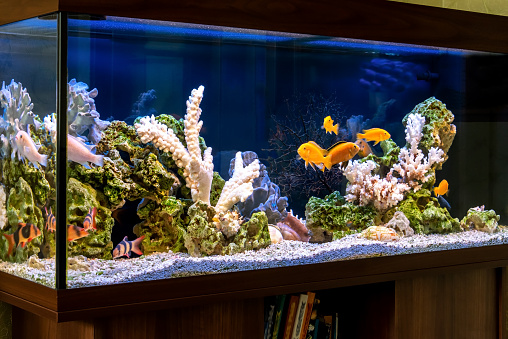Graceful beauty and engaging antics make aquatic life a better option to be chosen as pets. Aquatic animals increase the beauty of your home, and pet parents enjoy living with them because they do not disturb you like other pets. According to a survey by the American Pet Products Association in 2010-20, fish are the third most common animals (after cats and dogs) that Americans have kept as pets. About 13.1 million families in America have fish as pets in their homes. These figures may surprise you, but if you think about the beauty and grace of fish or other aquatic animals, you would not be surprised.
Aquatic animals have some needs that should be fulfilled in order to have a good experience of keeping them as pets. If you have an idea to bring aquatic life into your home, you should know about the things that are necessary for your aquatic partners. Taking care of aquatic pets becomes easy if you take proper and timely steps to fulfill the needs of aquatic pets. Here we will share some tips to take care of freshwater aquatic pets.
Pick a Suitable Aquarium:
The first thing to consider while you are bringing aquatic life to home is to choose the proper type and size of the aquarium. Different fish, for example, saltwater fish, freshwater fish, etc. require different types of aquarium to live healthily. Aquariums are available in different sizes and shapes, ranging from a small desktop aquarium to a large aquarium. A desktop aquarium is usually for a single or pair of fish, while a large aquarium may accommodate multiple numbers of fish. It would be best if you thought about different aspects regarding the aquatic habitat before bringing aquatic pets to your home.
Inappropriate size or type of aquarium may lead to adverse effects on the health and life quality of fish. Freshwater aquatic pets cannot live in an aquarium that is suitable for saltwater fish. The size of the aquarium also matters a lot; for instance, a large aquarium with one or a pair of fish is not a good choice. On the contrary, to this, a small aquarium crowded with multiple fish may lead to a decrease in the levels of oxygen and increase waste accumulation in the aquarium. This may lead to hazardous effects on the health of fish or even severe fatalities.
Opt for Best Freshwater Aquarium Plants:
You need to choose the right freshwater aquarium plants for freshwater pets. Aquarium or aquatic plants are those plants that are able to live or survive when entirely dipped and placed under the surface of the water. For freshwater aquatic pets, suitable freshwater aquarium plants include Anarchies, Echinodorus, Anubis, and Lilaeposis. These freshwater plant species have benefits that are easy to handle, and their care is simple. Other aquatic plants include:
- Cryptocoryne
- Hygrophila
- Ludwigia
- Vallisneria
- Microsorium
- Bolbitis
You should assess the compatibility or suitability of the plants with your fish and water condition before choosing the plant life for your aquatic pets. Fish can eat some types of aquatic plants and some plants may cause problems to the health of fish. For example, goldfish can eat betta food because it is a good source of protein.
Plastic plants are also available in the market that require less care, but these are not good for your aquatic pets. If you are willing to bring plastic plants to your aquarium, check their features, such as the look and size of plants that may fit in your aquarium.
Take Care of Condition of Water:
Specific and proper water conditions are essential for various types of aquatic pets. To improve the underwater environment for your aquatic pets, the following factors are necessary:
Conditioning the Water: Tap water is not ideal for aquatic life, so it needs conditioning to support aquatic pets. The most common conditioning methods include the addition of biological aquarium supplements after treating the water with a dechlorinating agent.
Maintaining Proper pH Levels: pH indicates the acidity or alkalinity of the water in the aquarium. Different types of fish require different pH of the surrounding water. The optimum pH for freshwater aquatic pets is between 6.8 and 7.5, and it varies according to aquatic species. At optimum pH, aquatic pets remain healthy, and the likeliness of disease occurrence decreases. Aquatic pet owners should keep a pH testing kit at home in order to check for any fluctuations in the pH of aquarium water. If you find any fluctuations in pH, take the necessary steps to maintain it within an optimal range. During 24 hours, if pH fluctuates more than 0.3, fish develops increased susceptibility to diseases.
Stabilizing Temperature: Aquatic life requires an optimum temperature to avoid any disturbance with the health of fish. Keep your aquarium away from heating sources like sunlight, air vents, stove, etc. to avoid abrupt changes in the temperature. Freshwater fish require temperature within the 72 °F – 82 °F range. An aquatic heater is a good option to maintain the temperature within an optimum range.
Other things for Proper Fish Tank Maintenance:
Apart from maintaining the proper condition of water in the tank, some other things also need to be checked regularly. Maintenance of nitrate concentration and keeping water clean in the aquarium or water tank is important that can be carried out by replacing 25 percent of water once in a month. To clean the waste or debris from the tank, a gravel vacuum can be used.
Algae usually accumulate in the tank and give the appearance of clouds on the interior walls of the tank that decrease the levels of oxygen in the water. Aquarium algae magnet or scrub brush can help to remove the algae from the water tank.
Regularly Observe the Aquatic life for Changes:
Give time to look for any change in the behavior, appearance, and appetite of the fish, or color of water, or condition of aquatic plants and aquarium. When you watch your fish regularly, you can manage them better. After making any change in the aquarium, make an extra effort to note your aquatic pets that will give you an idea about the future management of your fish. Ask experts about the supplementation and other queries about your aquatic pets.
The Bottom Line:
In conclusive remarks, we would advise you to be extra sensitive at each step while adapting aquatic pets. Before bringing your aquatic pets to the home, arrange a proper aquarium that can accommodate the number of aquatic pets you want to adapt, and has suitability with their type. Arrange a place away from heat sources and place an aquarium at that place. Keep check of all the parameters, including pH, temperature, and different chemicals. Place better types of freshwater plants that are not bad for your aquatic pets. Give time to the fish to know about their nature and things that are good and bad for them.
Also Read:
What is Exactly Rabbit? The Top Alternative of this Video Streaming Platform
A Comprehensive Guide On iPad Air 2 Screen Replacement


